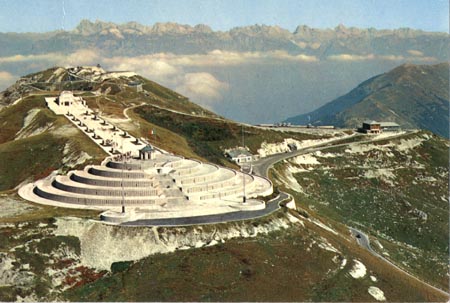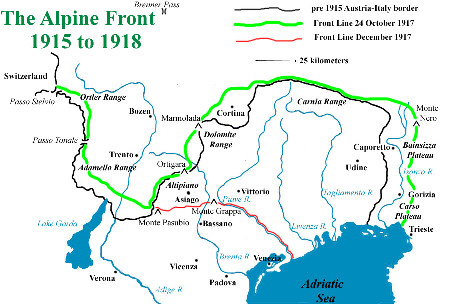
 Monte Grappa at the Summit TodayDi qui non si passa - From here none shall pass-The motto of the Italian mountain troops, the Alpini, since 1888. No battle defines Italy's struggle in la Grande Guerra better than Monte Grappa. Not only is it a tactical, political and morale watershed for the Italian military and people, the combat on the Grappa massif is also one of the greatest, unsung battles of World War One. Finding a history that mentions this battle is rare. The preliminary phase of what finished at Monte Grappa, the Twelfth Battle of the Isonzo or Caporetto, usually involves a paragraph in average history texts but the incredible conclusion, Italy's vindication if not survival, does not seem to fit in with the commonly told story. It is not history alone however, that tells the greatest story of Monte Grappa. The physical reality of this great mountain, viewed from the plains below or atop the summit, intensifies the story of the Italian Army's desperate courage and last stand in late 1917 and how incredibly close the combined Austrian and German armies came to total victory. The tomb of 25,000 Italian and Austrian warriors on its very summit bear mute witness to the armed struggle atop Monte Grappa--often called "Italy's Thermopylae."  Monte Grappa from the Venetian PlainThe strategic position of Monte Grappa did not go unnoticed by either side. The Italians built a later-day fort north of the summit, a formidable labyrinth of cannon and machinegun positions dug into solid rock--learning from the experience of their French brethren at Verdun. In 1917 and 1918 the Austrians and Germans saw the capture of Grappa as the key to flanking the entire Italian Piave River defensive line and to victory. The Italian forces would be cut in half, if not completely cut off from retreat. What unfolded on Monte Grappa was not one but three crucial battles in the year following Caporetto. They are described as La battaglia d'arresto in November and December of 1917; La battaglia del Solstizo starting 15 June 1918; and La battaglia conclusiva or Vittorio Veneto starting 24 October 1918. All three would center on this great mountain.  Italian Prisoners After CaporettoLike all armies in World War One, the Italians had adhered to one military principle--attack. Defense was simply preparation for another attack. Italy was not alone in high commands obsessed with attack and counterattack. In tactical doctrine the Italian Army was similar to all belligerents during the first three years of the Great War, mass infantry formations attacking along a wide front, with similarly dispersed artillery support versus concentration on weak areas. The results were likewise similar- a terrible attrition of men with negligible gain of territory. Italian advances during the eleven battles of the Isonzo [or elsewhere] were at best, little more than ten miles past the old frontier. Before Caporetto, the Austrians had launched only one offensive against the Italians, in the spring of 1916. The "Strafexpedition" or "Battle of Asiago" failed to break out of the Altipiano highlands due to rugged terrain and determined Italian resistance. As this Austrian offensive ground to a halt, the Russian Brusilov offensive was started to take pressure off the Italians and the great French struggle around the forts of Verdun. Several Austrian divisions were removed to Russia. Caporetto [starting 24th October, 1917] was brilliant in that it caught the Italian Second Army with most of their forces on the front line preparing for their own new offensive. The Austro-German Sturmtruppen units infiltrated weak avenues to rear areas- enemy strong points were bypassed and cut off. The other three Italian armies fell back to avoid similar entrapment. Italian gasmasks were hopelessly obsolete to the new German gasses. Both sides on this front had for the most part abstained from using lethal gas in combat. The venerable Emperor Franz-Josef considered poison gas unacceptable and forbade his army to use it. After his death, Austria eventually used gas only twice--once on the Isonzo in 1916, and on Ortigara [in the Altipiano] in 1917. The Austrian practice of finishing off suffocating, dying Italians with clubs only compounded the viciousness and no quarter on this front, with the Italians rarely taking prisoners in areas the Austrians had used poison gas. Italy had never used gas, and would not until 1918, with Allied encouragement and indeed, out of revenge. German flamethrowers were also devastating in trenches where clubs and knives had previously decided the victor.  Location of Monte Grappa on the Italian FrontAustrian strategy on Monte Grappa would involve capturing the eastern and western flanks of the mountain. A central attack was out of the question due to the Italian fortress dug into living rock underneath the summit. No weapon existed until 1945 capable of destroying Caserma Milano. In 1917 this would mean bypassing the fort and containing it. The western objective of the Austrian and German forces would be Monte Asolone. Here was the final southwestern ridge of Monte Grappa. From Asolone the vital supply road to the central peak could be observed and cut off. Logistical support on the massif also came from the elevated teleferica essential to the logistics of mountain warfare across this entire front. The most vital supplies came up and the seriously wounded were taken down in these cable cars. Other cargo was carried on the backs of men and mules. The great southeastern objective would be the aptly named Monte Tomba. From this great ridge, the Piave River and its trenches were in full sight. Atop Monte Tomba forward observers could direct artillery in support of Austrian river crossings, or to thwart Italian counterattacks. On the 16th of November 1917, the northern edge of the Grappa massif became the front line, with Austrian troops capturing Monte Tomacito and Monte Roncone. In the following days the Austro-German juggernaut captured one peak or ridge after another. By the 20th of November Col della Beretta and Monte Fontanasecca fell after savage battles. Two days later Monte Tomba was overtaken, although by days end the Italians had a slight advantage on ridge and summit. That same day [22nd November] only two kilometers from the summit of Monte Grappa, the trenches on Monte Pertica changed hands seven times in 24 hours. The Austrians eventually held this natural fortress. On the day Russia surrendered at Brest-Litovsk [15th December, 1917] and guns from the Baltic to Black Sea fell silent, Austro-German forces on the Grappa massif secured the two key peaks of Tomba and Asolone. When the clouds cleared from their summits, Venice could be seen. There was nothing between the Austrians and the sea save a few foothills and the Venitian plains. The view must have been incredible after one hundred miles of mountain warfare and trench fighting. The generals of the Germanic armies told their troops they would celebrate Christmas in Venice. The Austrians were so confident of success that campaign medals were already being struck to commemorate the capture of Venice. In their frozen stone trenches the Italians faced their two ancient enemies from the north--one spoke German and the other was winter's natural fury. The first desired destroy their nation; the latter might help preserve Italy. In snowstorm or cloudbank, close quarters combat was both unavoidable and instantaneous. Thrashed, often hastily regrouped Italian units faced continued attacks by the best units of the German and Austrian army. On Monte Grappa the Italian Army did not breakdown. Outnumbered, outgunned, with their backs to the abyss and their faces to onrushing enemy and winter weather, they found a renewed spirit that would carry on until victory the following year. They opposed German flamethrower and gas with rifle and bayonet counterattacks. Against torrents of artillery and trench mortars, these soldati hurled hand grenades and finally without ammunition, the mountain's stones. Over two thousand enemy artillery pieces surrounded this great mountain. The Germans considered this concentration "of a depth equal to the Western Front." Focused barrages destroyed one Italian stronghold after another…. yet a handful survived to fight on. The effects of artillery bursts in the mountains are greatly multiplied by barren rock. There is no soft Flanders mud to absorb the fragments. In alpine warfare, ricochet and stone splinters make trenches as deadly as open terrain. In late 1917 it was not only the troops on the front line who rallied to fight on. The entire nation held its breath, and as with the army, a new spirit gripped the Italian people. In a nation of endless mountain ranges, the survival of one peak would decide Italy's fate.  Austrian Troops at Monte Grappa |
||||||||

|
||||||||
|
||||||||

